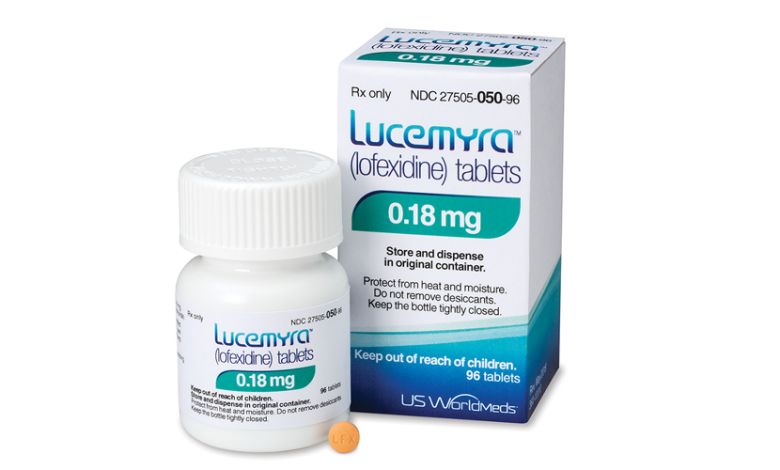Lofexidine (Lucemyra): Uses, Dosage, Side Effects, Reviews

What Is Lofexidine (Lucemyra) And What Does It Treat?
Lofexidine (Lucemyra) is a non-opioid prescription medicine used in adults to manage opioid withdrawal symptoms (e.g., sick feeling, stomach cramps, muscle spasms or twitching, cold sensation, heart-pounding, muscle tension, aches and pains, yawning, runny eyes, or difficulty falling asleep or staying asleep) that may occur after an opioid medication is suddenly stopped.
How Lofexidine (Lucemyra) works?
Lofexidine is in a class of medications called central alpha-adrenergic agonists. It works by relaxing blood vessels so that blood can flow more easily through the body. This action helps with the symptoms of opioid withdrawal that may happen when you stop taking an opioid suddenly. Lofexidine (Lucemyra) will not completely prevent the symptoms of opioid withdrawal.
What Is The Most Important Information I Should Know About Lofexidine (Lucemyra)?
Lofexidine (Lucemyra) is not a treatment for opioid use disorder. If you have been diagnosed with opioid use disorder, your healthcare provider may prescribe Lofexidine (Lucemyra) as part of a complete treatment program for your opioid use disorder.
Lofexidine (Lucemyra) may cause low blood pressure, slow heart rate, and fainting. Notify your healthcare provider right away if you experience these symptoms. If you take Lofexidine (Lucemyra) and have any of these symptoms, do not take your next dose until you have talked to your healthcare provider. You should stay well-hydrated and avoid becoming overheated during treatment with Lofexidine (Lucemyra) because that can increase your risk of low blood pressure and fainting. You should also be careful to stand up slowly from lying down or sitting.
After the period of time of not using opioid medications, you will respond to lower doses of opioids for pain. Do not begin using opioids at the doses you tolerated prior to starting Lofexidine (Lucemyra). This may increase your risk of overdose and death.
Lofexidine (Lucemyra) can potentiate the central nervous system depressant effects of benzodiazepines, alcohol, barbiturates, and other sedating drugs.
Lofexidine (Lucemyra) should be used in conjunction with a comprehensive treatment program. Lofexidine (Lucemyra) treatment should be discontinued by slowly decreasing the dose.
What Should I Discuss With My Health Care Provider Before Taking Lofexidine (Lucemyra)?
• If you have low blood pressure
• If you have a slow heart rate
• If you have any heart problems, including a history of heart attack or a condition called long QT syndrome
• If you have liver or kidney problems
• If you drink alcohol
• If you are pregnant or plan to become pregnant. It is not known if Lofexidine (Lucemyra) can harm your unborn baby.
• If you are breastfeeding or plan to breastfeed. It is not known if Lofexidine (Lucemyra) passes into your breast milk. Talk to your healthcare provider about the best way to feed your baby during treatment with Lofexidine (Lucemyra).
• Tell your healthcare provider about all of the medicines you take, including prescription and over-the-counter medicines, vitamins, herbal supplements, and any medications you may take for the individual symptoms of opioid withdrawal (such as pain relievers or medications for upset stomach).
• Tell your healthcare provider if you take benzodiazepines, barbiturates, tranquilizers, or sleeping pills. Taking Lofexidine (Lucemyra) with these medicines can cause serious side effects. Ask your healthcare provider or pharmacist if you are not sure if you are taking any of these medicines.
How Should I Take Lofexidine (Lucemyra)?
Lofexidine (Lucemyra) should be taken exactly as your healthcare provider tells you to take it. Do not change your dose or stop taking Lofexidine (Lucemyra) without talking to your healthcare provider.
Take Lofexidine (Lucemyra) with or without food. You should wait at least 5 to 6 hours between each dose. You should drink plenty of non-caffeine liquids unless told otherwise by your doctor. You should never take more than 16 tablets in 1 day and no single dose should exceed 4 tablets.
Consider using a calendar, pillbox, alarm clock, or cell phone alert to help you remember to take your medication. You may also ask a family member or a friend to remind you or check in with you to be sure you are taking your medication.
What Happens If I Miss A Dose Of Lofexidine (Lucemyra)?
If you miss a dose of Lofexidine (Lucemyra), take it as soon as you remember unless it is closer to the time of your next dose. Do not double your next dose or take more than what is prescribed. You should wait at least 5 to 6 hours between each dose.
What Should I Avoid While Taking Lofexidine (Lucemyra)?
Do not drive, operate heavy machinery, or perform any other dangerous activities until you know how Lofexidine (Lucemyra) affects you. Avoid drinking alcohol, using opioid pain medications (such as codeine, hydrocodone, oxycodone, or morphine), or using illegal drugs while you are taking Lofexidine (Lucemyra). They may increase adverse effects (e.g., sedation) of the medication.
Keep in mind that some cough syrups may contain opioid pain medication. Discuss all medications with your doctor and pharmacist prior to taking Lofexidine (Lucemyra).
What Happens If I Overdose With Lofexidine (Lucemyra)?
If an overdose occurs, call your doctor or 911. You may need urgent medical care. You may also contact the poison control center at 1-800-222-1222.
Signs and symptoms of an overdose include:
• Low blood pressure
• Slow heart rate
• Sedation
How Long Does It Take For Lofexidine (Lucemyra) To Work?
Lofexidine (Lucemyra) will begin working shortly after taking one dose. Lofexidine has a good oral bioavailability and the peak plasma concentration occurs after 2-5 hours of oral administration.
Can a pregnant woman take Lofexidine (Lucemyra)?
There is limited data on Lofexidine (Lucemyra) use in pregnant women to inform about drug-associated risk. The safety of Lofexidine (Lucemyra) in pregnant women has not been established.
Can a breastfeeding woman take Lofexidine (Lucemyra)?
There is no information regarding the presence of Lofexidine (Lucemyra) or its metabolites in human milk, the effects on the breastfed infant, or the effects on milk production. Caution should be exercised when Lofexidine (Lucemyra) is administered to a nursing woman.
Your healthcare provider and you should consider your clinical need for Lofexidine (Lucemyra) and any other potential adverse effects on breastfed children from Lofexidine (Lucemyra) or from the underlying maternal condition.
Is Lofexidine (Lucemyra) a safe medication?
This medication is safe and effective when used as prescribed. The safety of lofexidine was assessed across three randomized double-blind placebo-controlled trials. The trials enrolled 935 patients on short-acting opioids experiencing withdrawal. The combined dataset presented a similar safety profile and the drug was well tolerated. Adverse reactions that were reported in more than 10% of patients on lofexidine included orthostatic hypotension, bradycardia, dizziness, somnolence, sedation, and dry mouth.
Is Lofexidine (Lucemyra) an effective medication?
Lofexidine (Lucemyra) has been shown to be as effective as clonidine at controlling some of the symptoms of withdrawal from opioid use. It may have a small additional benefit for maintaining abstinence in patients switched to buprenorphine or methadone for long-term maintenance.
What Are The Possible Side Effects Of Lofexidine (Lucemyra)?
Common side effects
• Low blood pressure or symptoms of low blood pressure (e.g., lightheadedness)
• Slow heart rate
• Dizziness
• Sleepiness
• Dry mouth
Rare/serious side effects
• Irregular heart rhythms: Notify your healthcare provider if you have a history of congestive heart failure, slow heart rate, liver or kidney problems.
• Opioid overdose: If you complete opioid discontinuation, you are likely to have a reduced tolerance to opioids and are at an increased risk of a fatal overdose if you resume opioid use.
• Discontinuation syndrome: Marked rise in blood pressure and symptoms of diarrhea, insomnia, anxiety, chills, sweating, and extremity pain. Lofexidine (Lucemyra) must be discontinued gradually.
Are There Any Risks For Taking Lofexidine (Lucemyra) For Long Periods Of Time?
Lofexidine (Lucemyra) is not indicated for long-term use. Lofexidine (Lucemyra) treatment usually lasts for 5 to 7 days following last opioid use. It may only be continued up to 14 days with dosing guided by symptoms. Lofexidine (Lucemyra) must be discontinued gradually over a 2 to 4-day period.
What Other Medications May Interact With Lofexidine (Lucemyra)?
Lofexidine (Lucemyra) may increase the depressant effects of benzodiazepines, barbiturates, and other sedating drugs.
Paroxetine (Paxil®) may increase the absorption of Lofexidine (Lucemyra), which can increase the side effects of Lofexidine (Lucemyra) (e.g., low blood pressure, slow heart rate). Lofexidine (Lucemyra) may reduce the effectiveness of oral naltrexone (Revia®) when given within 2 hours of each other. Taking Lofexidine (Lucemyra) and methadone together may cause irregular heart rhythms. Concurrent use requires cardiac monitoring.
Your pharmacist or doctor will help you to determine if other medications you take can interfere with the effects of Lofexidine (Lucemyra).





